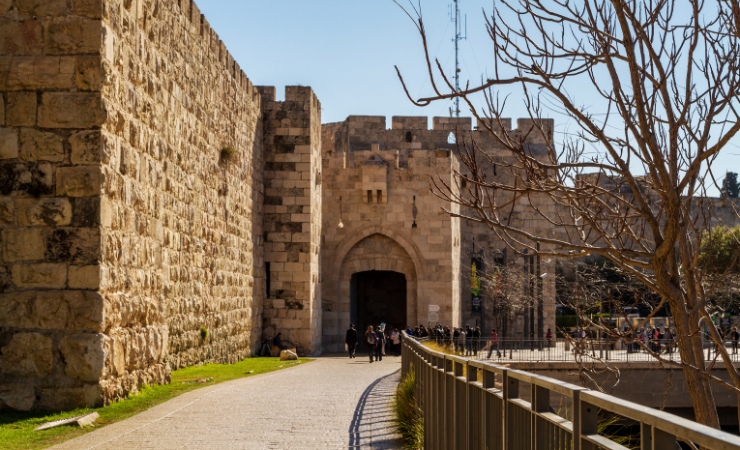Discover the Ancient Wonders of the Jaffa Gate, Jerusalem
Introduction
The Jaffa Gate, one of the seven main entrances to Jerusalem’s Old City houses a few magnificent stories that span more than a millennia.

Location
The Jaffa Gate is situated on the western edge of the Old City. It’s a junction where ancient history and modernity collide. It is one of eight gates in the wall of the old city of Jerusalem. The gate leads to a bustling marketplace, the lively streets of the Armenian and Jewish Quarters, and the legendary Tower of David.
History of the Jaffa Gate
In the early 16th century, Jerusalem was under the rule of the Ottoman Empire. Sultan Suleiman the Magnificent, known for his ambitious architectural endeavors, sought to fortify and beautify the city. So, circa 1536, Suleiman commissioned the construction of a grand wall to encircle Jerusalem. This 4.5km wall was meant mostly to solidify the sacred status of Jerusalem in the Islamic world.
The Jaffa Gate was one of the main gates built into this wall, and it was strategically placed to serve as the western entrance to the city. Named after the port city of Jaffa, which was the traditional end of the highway leading from the coast to Jerusalem, the gate was essentially a conduit for pilgrims, merchants, and travelers coming into the city.
The gate, with its imposing stone structure, also known as “Bab el-Khalil,” meaning “Gate of the Friend,” (the friend referring to Abraham). The name Hebron Gate also stems from this, as, by tradition, the burial site of Ibrahim/Abraham is in Hebron, whose Arabic name is el-Khalil.
The design of the gate is L-shaped to force anyone who entered to make a right-angle turn, thus slowing down potential invaders.
The Jaffa Gate has stood the test of time, bearing witness to the march of history. It has seen empires rise and fall, and it continues to serve as a reminder of Jerusalem’s ancient glory and Suleiman’s lasting architectural legacy.
In 1898, German Emperor Wilhelm II and his wife, Augusta Victoria, visited Jerusalem. The Ottoman authorities, wanting to honor him, broke down part of the wall next to Jaffa Gate to allow the Kaiser’s carriage to pass through more easily. This alteration still exists as an open plaza next to the gate. Ten years later, in 1908, an ornate clock tower (one of six clock towers in Israel and one hundred though out the Ottoman Empire) was built above the gate to celebrate the 25th year of Sultan Abdul Hamid II’s rule. This clock tower was later removed by the British Governor Sir Ronald Stores in 1922.
Combining this historical context with the previously discussed biblical context, archaeological findings, and nearby attractions, the Jaffa Gate stands as a testament to the rich tapestry of history that Jerusalem embodies. It’s a must-visit for anyone seeking to connect with the deep historical and spiritual roots that have shaped the course of human civilization.



Sources and Additional Reading
BibleWalks – Jaffa Gate
Jaffa Gate – Wikipedia
Sites Near the Jaffa Gate
- Tower of David: Also known as the Jerusalem Citadel, the Tower of David is an ancient citadel located near the Jaffa Gate entrance to the Old City. The citadel dates back to the Crusader, Mamluk and Ottoman periods.
- The Jewish Quarter: The Jewish Quarter is a treasure trove of history and culture. This area is home to several ancient synagogues, and historical buildings, and the Broad Wall erected by King Hezekiah in the 8th century BC.
- Christ Church: This is the oldest Protestant church in the Middle East, was inaugurated in 1849.
- The Armenian Quarter: Home to a tight-knit Armenian community. Rich in history, it houses the St. James Cathedral, a place of ornate beauty, and offers a unique blend of Middle Eastern and Armenian culture through its narrow streets, ancient buildings, and traditional craft shops.
- St. James Cathedral: This cathedral is part of the Armenian Patriarchate. The cathedral is dedicated to two Saints named James – St. James the Greater, one of Jesus’ twelve apostles, and St. James the Just, who was the brother of Jesus.



